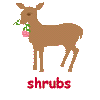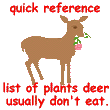GARDENING WITH DEER
PERENNIALS AND OTHER MEDIUM SIZE PLANTS THAT DEER USUALLY DON'T EAT
.........California natives are in bold type
A perennial is a plant that dies back after flowering or in the winter, but will begin growing again in the appropriate season.
In plant care descriptions you will often read "treat as a perennial". That means you cut the
plant back hard after bloom or in the winter. A lot of the plants listed here are not true perennials, but we use them in our gardens as if they were.
- Allium
- Ornamental onions, usually with pink or lavander rounded balls of flowers. A full range of sizes, some are quite large, 3-4ft. tall.
- Amaryllis
- ("Naked Ladies") A bulb that grows a lot of strap like foliage in Spring. The foliage goes dormant in Summer before the 2 ft. high stalks of large, fragrant, pink trumpet flowers appear. Tough and totaly drought tolerant.
- Artemesia
- Many different varieties exist of these usually silvery, ferny, tough, spreading and sometimes invasive plants. The best varieties don't flower or have white flowers.
- Catanache
- ("Cupid's dart") Blue, slightly papery flowers are on stalks about 12 - 18 in. high above the small basal foliage clump. Plant a group to make an impact. Very pretty and tough.
- Centaurea cineraria
- ("Dusty Miller") Silvery mound about 18 in. high and wide with purple flowers.
- Chives
- Sweet, edible, flowers are small pinky balls.
- Chrysanthemum maximum
- ("Shasta Daisy") Big white daisies on tough, spreading plants. There is a lot of variation in flower size and shape, and general size of th plants.
- Chrysanthemum parthenium
- ("Feverfew") There is a yellow green leafed version and a regular green one. Both grow about 2 ft. high and wide, have white flowers and seed themselves about. Winter seems to be there favorite time to grow. There is also a tiny clumping version of the golden leafed one.
- Crocosmia
- Growing from corms, a very tough, spreading, even invasive. Sword shaped leaves about 2 ft. high and bright orange flowers on arching stems. Once a clump is established it is dought tolerant and no weeds grow with the clump.
- Daffodils
- Early Spring blooming bulbs, usually a cheerful yellow. They will eventually form sizable colonies. Normally about 1 ft. high, there are minature ones that are very sweet.
- Datura inoxia
- About 2 ft. tall and 3 ft. wide with grey green very tropical looking foliage and fantastic white trumpet flowers that are fragrant on warm nights and early mornings. Grow as an annual in colder areas. Poisonous
- Dierama
- ("Angel's Fishing Rod") Stunningly beautiful with tall thin strap-like foliage and long arching slender stems from which hang pink to purple flowers.
- Digitalis
- ("Foxglove") An old fashioned "cottage garden" plant. The biennials have tall (3-4ft. tall) flower spikes, and are usually shades of pink, white or purple. The Perennials are mostly shorter and some are apricot or yellow, or other odd variations.
- Echium
- There are versions that have wonderful big spikes of flowers, but they are really only do well in coastal areas with little frost. The annual version is a short, hairy leaved plant with very nicely colored (pinky fading to blue) papery flowers. If happy they will reseed nicely.
- Erysimum 'Bowle's Mauve'
- Evergreen, but usually blooms itself to death its first year. If pruned back may have enough vigor to continue. Nice rounded form to about 24 to 30 in, covered with Mauvey flowers all winter into spring. Try to find and plant in Fall.
- Euphorbia
- A real stand-by for Deer Gardens. They come is many versions,from ground hugging to 4 footers. Most have acid yellow-green "flower" heads, and some have purply foliage. Be careful not to get sap on your skin or in eyes.
- Ferns
- Most ferns seem to be left alone by deer. A very useful fern in Sonoma County is Polystichum munitum, the native sword fern.
- Helleborus
- ("Christmas Rose"," Lenten Rose") Evergreen perennials with fascinating, face down flowers usually. Flower colors range from odd muted pink-greens to speckled whites and shades of pink or green. They do well in partial shade, some bloom in the winter or very early Spring.
- Iberis sempervirens
- Evergreen, low, dark green with white, or sometimes pink, flowers in early Spring. Good for edging and fronts of flower beds.
- Iris douglasiana
- The native iris is usually purple, but there are selections and hybrids in almost every color. About 18 to 20 in. high, forming slow spreading clumps of evergreen foliage. Drought tolerant, full sun near coast, partial shade inland. A good plant for unwatered areas under Oaks.
- Iris siberica
- Grows about 3 ft. tall, lovely flowers, mostly in shades of purple to white. Herbaceous.
- Iris ensata
- ("Japanese Iris") Moisture lovers, best at the edge of ponds. Absolutely stunning flat flowers. Herbaceous
- Kniphofia
- ("Red Hot Pokers") Big spreading clumps of 2-3ft. high foliage and even taller odd orange and yellow flowers. Tough.
- Leonotis
- Very impressive orange wooly flowers on a 2-3 ft. dark green perennial. Seems to want warmth to do well.
- Lepechinia hastata
- One of my new favorites. Strongly aromatic big silvery leaves form a mound about 2 ft. high and wide. In late summer spikes of bright magenta flowers are held about a foot higher. Blooms for a long time and seeds about just enough. Remove spent flowering stalks to preserve good appearance.
- Lily, Asiatic
- The Asiatic Lilies seem be left alone by the deer. Other types don't seem to fare as well.
- Lithodora
- Awesome intense blue flowers in early Spring on low evergreen foliage. Wants good drainage, but seems to need some water. Beautiful in rock garden type settings.
- Lobelia
- Lobelia syphilitica, with its 3 ft. tall blue flower spikes is not eaten usually. It wants partial shade and regular water. The other Lobelias are worth trying.
- Lychnis
- There are several variations of these but the ones I have seen be deer tolerant are those with a basal cluster of silver leaves, and either bright magenta or soft white and pink flowers on stalks about 1 ft. high. Short lived, evergreen perennials that seed themselves about willingly.
- Marguerite
- Not very exciting, but they are cheerful, these evergreen bushes that grow to about 2-3 ft. high and wide and have bright yellow flowers.
- Narcissus
- Bulbs that bloom early spring, usually are white or soft yellow and are fragrant.
- Oregano
- Some in this genus make good ground covers with their evergreen mats of foliage. The flowers on those kinds range from very showy to ho-hum, and grow from a few inches high to almost 2 ft. There is another type - the ones that have papery bracts that resemble hop flowers hanging down from wiry stems. These seem more drought tolerant, and definitely need very good drainage. Most reach about 1 ft. high with their arching flower stalks and are exquisitly beautiful.
- Ornamental Grasses
- So many types, all sizes, many forms, and with different cultural needs.
- Papaver somniferum
- ("Breadseed Poppy") Annual, tall, to 3 ft., easy and showy with big papery flowers. Colors range though the reds and pinks to white. Beautiful. Seed in Fall or early Spring.
- Peony
- Surprising to me deer seem to leave the herbaceous Peonies alone.
- Perovskia atriciplicifolia
- Two varieties of Perovskia have lacy greyish foliage and plumes of soft lavander purple flowers for a long season. They are good for the middle to back of the border, growing about 3 ft. tall. Perovskia 'Longin' has dense silver leaves, a compact habit, nice blue flower color and grows about18 in. tall.
- Phlomis
- ("Jerusalum Sage") Not a sage, but a wonderful functionaly evergreen plant with aromatic leaves and Whorls of yellow flowers on 3-4ft. stalks in spring. When the flowered stalks are cut all the way off when faded there is new foliage coming to take their place. I think of this plant as having about a 3-4ft spread.
- Romneya
- ("Matilija Poppy" or "Fried Egg Plant") A big showy native plant, spreading to form large colonies where happy. The huge papery white flowers with yellow centers appear about June on 3 -4 ft. high stalks above silvery foliage. Can be managed as a back of the border plant, cutting out flower stalks all the way when they fade.
- Salvia
- There are many sages, some native. They are not all deer tolerant, some of the good ones for around here are Salvia 'Phyllis's Fancy, Salvia leucantha ("Mexican bush sage"),
Salvia brandegei, Salvia clevlandii, Salvia leucophylla, and various native hybrids such as Salvia "Purple Ginny'.
The Salvia greggii hybrids are very colorful and useful, but can be short lived, and occasionly are munched by deer. Salvia guaranitica comes in a stunning shade of blue, wants water and does well in some shade. For the front of the border are Salvia superba in different shades of purple and Salvia nemerosa, my absolute favorite being 'Blue Hills'.
- Saponaria
- ("Soapwort" or "Bouncing Bet") Soft pink perennial, easy, sorta floppy, to about 24 in. high and spreading. One version, Saponaria 'Max Frei' is very low growing and makes a very pretty 2-3ft. circle of pink in the summer.
- Senecio Vira Vira
- Evergreen silver mound grows to about 3 ft. high and wide. Small buff yelow flowers are insignificant.
- Teucriums
- Great family - deer seem to leave them all alone. I think all are evergreen, but foliage color can be dark green, light green, grey or silver. Flower colors are either rosy lavender or a nice blue. You can find Teucriums that hug the ground and ones that tower at 8 ft. tall.
- Tradescantia virginiana
- ("Spiderwort") clumps of dark green thick grass like leaves about 18in. to 30 in. tall. Simple three-petaled flowers in shades of purple to pink, that change color when exposed to radiation appear a few at a time almost all summer. Want shade and are fairly drought tolerant, but can handle wet areas.
- Verbascum
- ("Mullein") The big wooly ones with yellow flowers are deer tolerant as are the much sweeter and shorter Verbascum chaixii, with their apricot or white flowers. I'm not sure about some of the others, but they are worth trying.
- Watsonia
- 3 -4 ft. tall spikes of skiny gladiolus type flowers in shades of hot pink to white appear in Spring. Rough and tough, not the most refined plant if left on its own, but can be kept groomed and fit into flower border.




